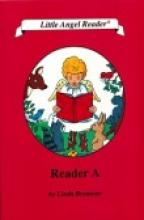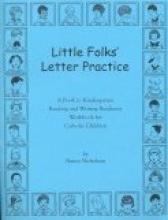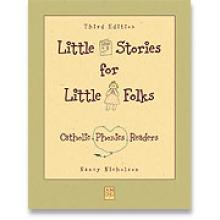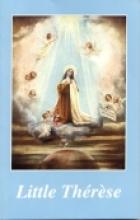No name
Little Angel Readers
The Little Angels Series are four soft cover readers that teach all phonics sounds using word drill pages and phonetic stories. It teaches letter-sound relationships systematically, beginning with the easiest letter sounds. The word drill pages provide practice in decoding words containing the letter sounds. The stories with phonetically-controlled vocabulary follow each word drill page. They provide practice in decoding words in context and build comprehension skills. The stories are about Catholic family life, Bible stories, and Saint stories as well as fables and folk tales. The illustrations are well done and many are in color. Review pages are provided at regular intervals.
The workbooks are consumable and accompany the readers. They reinforce the lessons from the readers with exercises in phonics, vocabulary, reading comprehension and handwriting.
The Teacher's manual provides detailed lesson plans and suggestions for related activities. The manual provides daily lesson plans for teaching the entire series. The lessons cover reading readiness, phonics, listening skills, vocabulary, handwriting, comprehension and spelling. There are also multi-sensory activities included to accommodate children who have different learning styles. The pace is very flexible so you progress at *your* child's speed. The manual also contains progress test after each review to assess how well your child is doing.
Sequence of Phonics Reader A - Consonants, short vowels Reader B - final blends, -ed, -ing, long vowels, two-syllable words Reader C - Beginning consonant blends, Y as a vowel, Consonant digraphs, R- controlled vowels Reader D - vowel digraphs and diphthongs, soft c and g, Irregular sounds and spellings
The author holds a MEd in Reading from the University of Missouri-St Louis and is certified in Learning Disabliites. She has six years classroom experience and nine years experience in home education.
I am using the Little Angels in place of the MCP phonics that Seton sends with their First Grade Curriculum. If you need something for Kindergarten, with beginning sounds and letter recognition, I highly recommend Seton's Kindergarten Phonics for Young Catholics. I have had great success with the Little Angels series with my daughter who is now finishing Reader D. She is 8 years old. My son who is 7, could not wait to start the readers and is also on Reader D. The Little Angels Phonics Series is really a wonderful tool for teaching your children to read.
Little Folk's Letter Practice
We reviewed Little Folks' Letter Practice. We found this to be very simple. For our child this was too easy for K level. It is basically for the Pre-K level. It has pages that are of coloring book quality. We photo copied the pages to make them easier to write on with a pencil. The letters of the alphabet are one to a page with a trace and write page following each letter. The pictures with each letter try to complement our faith. The introduction offers creative advice for the use of the book. The last 5 pages of the book encourage the child to sound out words. There are four or five possible words in a column. A blank has been left in front of each word, such as 'an'. Pictures to the possible word are in the right hand column to assist the child in the discovery of the word. The child will need to sound out the word in the column look at the pictures such as 'man' and write the consonant. There are no difficult words to sound out. All words are only three letters such as 'man', 'cat', 'mop', etc. This is a nice book for becoming familiar with the alphabet.
Little Folks' Number Practice
This simple workbook provides practice for preschool and kindergarten aged children in writing numbers, counting objects and considering religious ideas associated with each number (one God, two natures: human and divine, three Divine Persons, four marks of the Church: One - Holy - Catholic - Apostolic, five Sacred Wounds, etc.). There are three pages each for the numbers one through ten which contain writing lines for handwriting practice of the numbers, related black and white illustrations to color, pictures to circle and count, etc. The remaining pages provide practice in counting sets of things ("circle the correct number" for several pages and "write the correct number" for others). The final eight pages offer simple exercises involving numerical order, more and less, some very basic addition and simple shapes. The pages would have to be read aloud to young children.
Copyrights 1997/2002
Little Saints
I'm just thrilled with it the Little Saints program on my first overview. The subtitle of the book is "A Catholic Preschool Program with Classical Disciplines", and it is just what I wanted last year! I'm going to try it with my soon-to-be-3 year old and my Kindergartner this year.
Last year, I purchased one of the Five in a Row (FIAR) volumes, but FIAR just didn't mesh well with our gang. My 4 year old (who is the size of an 8 year old and looks like a meat packer, but is really an "artsy" teddy bear at present) was bored by re-reading the same book for a week, and he wasn't too thrilled with the question/answer/research type of work. He wanted to MAKE things and read MORE books...sounds like his mama!
The Little Saints program is *not* a phonics or math or "academic" preschool program, although phonics and handwriting and basic math information is included. It is heavily based in literature, religion, and the arts. I'm overwhelmed as it is *just* what I would have wanted to do had I the proper background....and a dozen years of free time.
The program is laid out by month, with "themes" for each week during the months of August through May. The 40 themes are those typical of preschool: seasons, family life, animals, senses, people around the world, and so on. Each theme is organized into a 3-day school week, with many ideas of activities for that day.
Every "day" has notes for the teacher as to the basic goal of the day, a short quote from the Bible (which I will be using for copywork for my Kindergartner), storytime, nursery rhymes, poetry, story-telling and finger plays (memory work), songs and circle games, at least one learning game, and an art project. The first pages of each week/theme clearly lays out for the busy parent: exactly what materials are needed for each game and each project, a listing of the skills being worked on that week, a listing of correlated classical music for music appreciation, and a long listing of picture books on the theme of the week. Most of the titles of the picture books are familiar to me, so they are either "classics" or easily found at the library.
The appendices include the text of the rhymes and finger plays and songs. The author notes that if you repeat the program for a second year that you will notice a considerable difference between a 3 year old child and a 4 year old child.
In short, I'm just thrilled with this program.
Little Stories for Little Folks
The Parent's Guide offers steps to prepare your child to read by using the enclosed flashcards (printed on card stock) to gain letter and sound recognition and then proceeding to work on pre-reading blends (with the pre-reading sound blend sheets that are included in the program and printed on card stock). After these steps are accomplished, the child will be ready to proceed to the phonics readers. The parent's guide also offers discussion questions to help your child get more out of each story.
There are four sets of readers, each set being identified by its own color. The booklets and flash cards come as an 8 1/2 x 11 pad. Each booklet starts out as a regular-sized piece of paper which you fold into four to form a child-sized booklet.
 Level 1 contains 15 booklets. The story titles are: "At Mass", "Stop! Hot Pot!", "Sad Nip", "Mud on the Rug", "The Hot Pup", "Mom Gets Help", "The Rat", "Little Ann", "Bat the Ball", "Funny Ann", "The Campers", "God With Us", and "Messy Room".
Level 1 contains 15 booklets. The story titles are: "At Mass", "Stop! Hot Pot!", "Sad Nip", "Mud on the Rug", "The Hot Pup", "Mom Gets Help", "The Rat", "Little Ann", "Bat the Ball", "Funny Ann", "The Campers", "God With Us", and "Messy Room".
This set starts with simple words such as "pat" and "sat" and progresses slowly to more complex words like "tent", "small" and "under".
 Level 2 contains 10 booklets. The story titles are: "Dad's Cake", "Mrs. May is Sick", "Mike's Bike", "Visit the Sick", "We Hope to See the Pope", "The Little Goat with No Sense", "The Cold Rain", "Feed the Hungry", "The Tease", and "Noon Potluck."
Level 2 contains 10 booklets. The story titles are: "Dad's Cake", "Mrs. May is Sick", "Mike's Bike", "Visit the Sick", "We Hope to See the Pope", "The Little Goat with No Sense", "The Cold Rain", "Feed the Hungry", "The Tease", and "Noon Potluck."
This level starts with words like: "cake" and "taste" and progresses to words like "salad", "baby" and "table".
 Level 3 contains 10 booklets. The story titles are: "Ann Cleans the Church", "Blessed Sacrament", "St. Paul", "A Toy for a Boy", "At the Beach", "The Found Rosary", "Run the Race", "School, Where?", "The Quake", and "I Didn't Know".
Level 3 contains 10 booklets. The story titles are: "Ann Cleans the Church", "Blessed Sacrament", "St. Paul", "A Toy for a Boy", "At the Beach", "The Found Rosary", "Run the Race", "School, Where?", "The Quake", and "I Didn't Know".
The starts with words like "kneel" and "holy" and progresses to words like "receive" and "neighbor".
 Level 4 contains 10 booklets. The story titles are: "The Bright Star", "The Caught Calf", "Mr. Brown's First Holy Communion", "Kim's Adoption" (in two parts), "In the Match Box", "Badge Fudge", "Squirt", and "Our Lady's Secret".
Level 4 contains 10 booklets. The story titles are: "The Bright Star", "The Caught Calf", "Mr. Brown's First Holy Communion", "Kim's Adoption" (in two parts), "In the Match Box", "Badge Fudge", "Squirt", and "Our Lady's Secret".
This level starts with words like: "night" and "follow" and progresses to words like "cheerfully" and "enough".
Set contains:
22 page softcover parent's guide, set of 45 booklets, 47 flashcards
Copyrights 1998/2004
Donated for review by Catholic Heritage Curricula
Little Stories for Little Folks
4 levels, 45 stories to fold into booklets, bound Parents' Guide, Silly Willy Sentences activity, and Catholic flashcards on stiff cardstock
Little Therese
Living the Liturgical Year: Volume 1
The second chapter provides detailed ideas for Home Education during Advent by means of a unit study on the time before Christ. This unit study ties together a certain amount of History, English/Vocabulary, Geography, Religion, Math, Literature, Health, Religion, Art, Science, Home Economics and Latin/Music in order to delve deeper into the meaning of Advent.
Chapter three covers Advent Recipes which differ from older books because of a more modern emphasis on natural foods. I would also have to explain that the recipes are not necessarily "traditional" Advent recipes, but rather natural food recipes that would be considered appropriate for Advent. This chapter includes an extensive segment on growing sprouts as well as recipes for dishes (along with explanations of why they are appropriate) such as: Avocado Potato Salad; Root, Sprout and Flower Noodle Salad; Carrot Salad Fish Loaf, Beet Soup, Avocado-Cauliflower Cream Soup, Carrot Cake and Sprouted Sunflower Burgers. All recipes in the book are meatless and in fact contain no animal products (making them cholesterol free). A four page section in the middle of the book provides glossy, full-color photos of the recipes, many of which incorporate festive decorations. The book also includes an extensive bibliography, a listing of sources for materials and foods mentioned in the book and an alphabetical index of recipes.
This book was donated for review by the author.
Look! Seeing the Light in Art
I found this quite accidentally when browsing the art shelves in the non-fiction children books section at our library system's main branch last week.
Mind you, I am always carting around mountains of books in huge, oversize bags, and I am thankful for strong, teen sons, and for downtown ballet and piano classes allowing me the time to browse at the library.
At the library, I try to throw in the bag only what looks promising, and I still end up bringing home volumes that go directly back into the return bag, almost unopened. So what I post here is truly the cream of the crop-- at least the cream of my own random crop!
Back to Wolfe's marvelous book: she is from the UK and has received awards for her art books for children. I would give her an award as well! (I have just requested the two other titles in this series from Inter Library Loan). I like the paintings she chooses to show her artistic points-- in this volume, the effect of light onto works of art-- and I like the language she uses to talk about them. The book is for children and yet it doesn't talk down or use patronizing language. Art should be talked about simply, clearly-- and she does just that, as she discusses the use of light in different aspects using 18 great works of art as examples. In fact, I am taking this book to take to my art students at co-op on Friday, and my teens at home approve!
The only negative thing I would say is that I would have chosen another of the many art works depicted in the book for the cover. Alas, that may be a very insignificant point, but it is one that could mean a lot to a visual person like me, who had to bet on the stunning art wok inside the book when the cover shows a very boring Picasso.
To close, another positive: Wolfe is not afraid to acknowledge that it is impossible to talk about art without discussing sacred art. Indeed her book opens with the gorgeous Conversion of Saint Paul by Caravaggio (so timely for the Year of Saint Paul!), and it closes with a discussion on "Heavenly Light", using Blessed Fra Angelico's version of Paradise from The Last Judgement.









